Upcoming Screenings:
no event
Follow us on Facebook
HELP BRING FINDING KUKAN TO CLASSROOMS
Sign up for our mailing list.
Tag Archives: Asian American
November 29, 2014 — Year in Review (Part 2 — New York in June)
New York in June could only be made possible by the hospitality of longtime friend Peer Just. A free place to stay in New York meant that I could funnel some of our funds towards filming two crucial interviews with Asian American scholar Judy Wu and the award-winning author Danke Li. Both provided important insights into Li Ling-Ai’s motivations and how World War II transformed the everyday lives of women in both the United States and China. Answering the last-minute call for camera help were our New York go-to DP Frank Ayala and another longtime friend Ruth Bonomo.
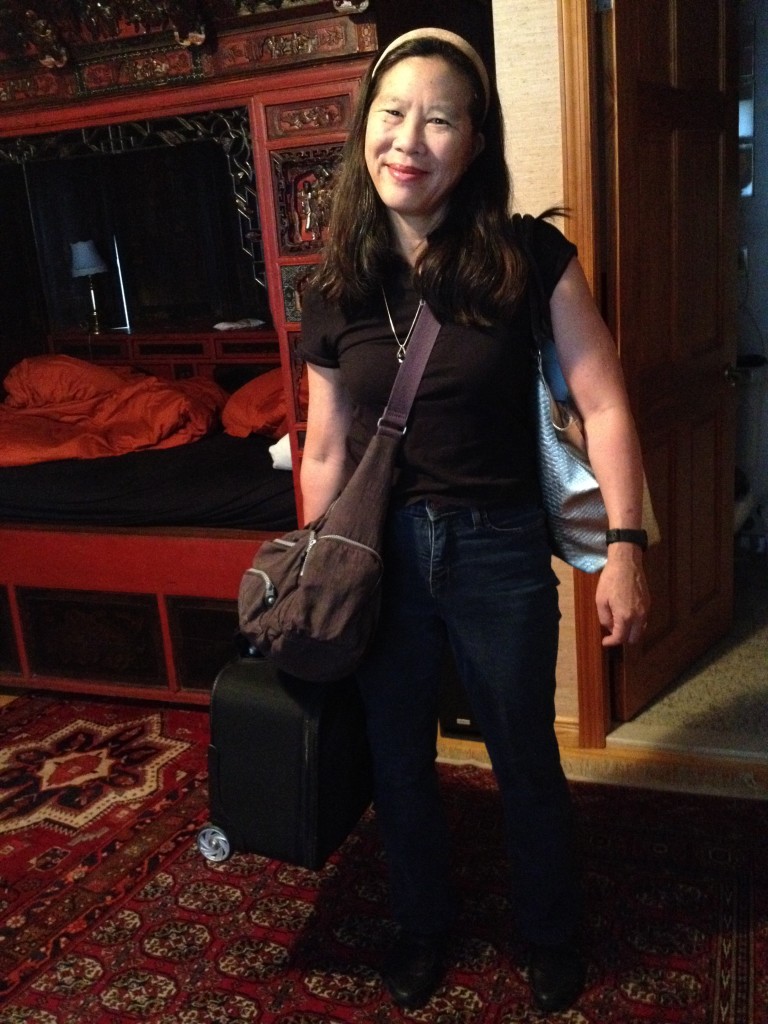
Leaving NYC home base for a day of production on Long Island — first the subway, then the train, then the ferry.
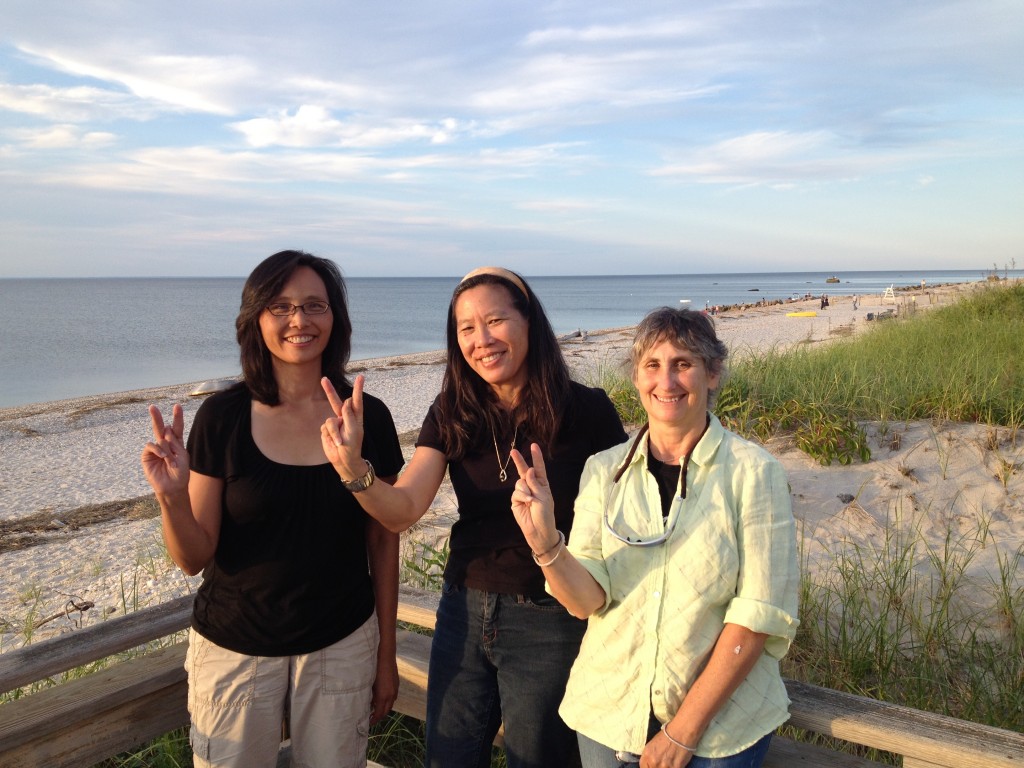
Judy Wu, author of DR. MOM CHUNG, took time out from her Port Jefferson vacation to sit for a great interview. Ruth Bonomo pitched in as DP on short notice, providing wheels, camera and lights. Judy’s family fed us a great spaghetti dinner beachside. Signing K for KUKAN!
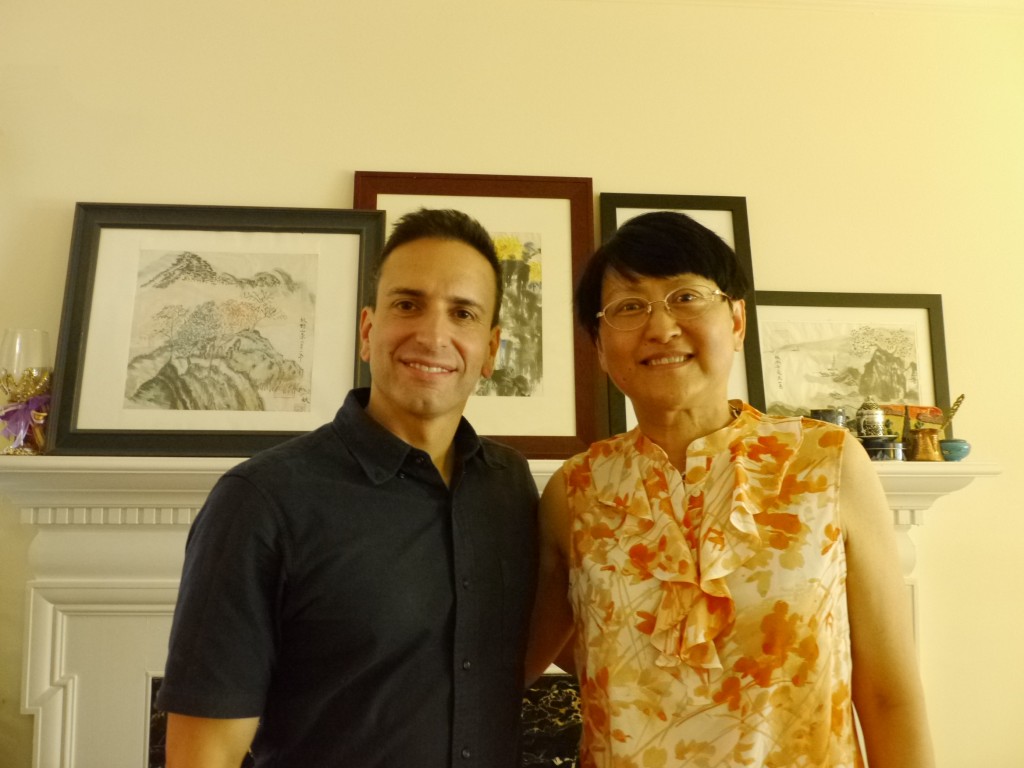
DP Frank Ayala with Danke Li, author of ECHOES OF CHONGQING, WOMEN IN WARTIME CHINA
A visit to New York also meant I got to hang out with Calamity Chang, who has volunteered to record temporary voice over lines that allow us to edit our historical scenes. Calamity constantly inspires me by her willingness to embrace her performance instincts and bare it all in her wonderfully tongue-in-cheek burlesque shows. She also knows her Chinese history and promotes projects like ours that bring it to the forefront. Her musician/photographer husband Mike Webb put in hours of free time as our sound man while dog Chewie quietly put up with our intrusion. After a super long recording session on a sunny Sunday afternoon, we all needed a New York specialty cocktail.

Going over scripts with Calamity Chang.

Musician and Photographer Mike Webb pitches in as sound man to record our temporary voice over tracks.

Chewie after a long recording session

One of the killer cocktails I had in NYC featuring cucumber and gin
Just being in NYC is a real shot in the arm for a filmmaker. Visual stimulation is everywhere and so are other artists whose very existence and work are like cheers from the sidelines.

Inspiration from Steven Salmieri and his wife Sydney Michelle

Inspiration from artist, hat designer and jewelry maker Carol Markel

Inspiration from my husband Paul Levitt who is designing a book with Dana Martin about his visit with Man Ray

More inspiration from a screening and Q&A with D.A. Pennebaker and Chris Hegedus
Before my New York trip I got word that I received a fellowship to go to China to join a group of high school educators form Canada and New Jersey on a World War II centered study tour. It would be my first trip there, so China was on my mind.

Looking ahead to China in July at the Ai Wei Wei exhibit in Brooklyn

Imagining China

China Kitsch
Li Ling-Ai’s spirit is also close at hand when I am in NYC. Her great friend Larry Wilson offered to point out the third floor apartment where she spent most of her life on West 55th street. The breeze picked up and the trees outside the apartment did a dance as we looked up to the third floor.

The Power of the Press, Part 2 — Roy Cummings
A blog in support of FINDING KUKAN’s 10K in 10weeks “Keep This Film Alive Campaign”.
How was the pioneering female reporter May Day Lo connected to KUKAN’s co-producer Li Ling-Ai? Leads to that question had dried up for me a long time ago. Then last November Honolulu Star-Advertiser reporter Mike Gordon wrote a big feature article about FINDING KUKAN. I received a number of enthusiastic emails about the article and one strange phone call.
“I’m so mad!” Those were the first words Susan Cummings said to me. “I’m sure he knew her. If only he were still here, he could tell you.” She was referring to her husband who was no longer alive. To tell you the truth, I thought Susan might be a raving lunatic. But as we talked longer I realized that Susan’s late husband was Roy Cummings. He’d been a reporter at the Honolulu Advertiser in 1937, the same year KUKAN’s director Rey Scott started working there. Like Rey Scott, he had roots in Missouri. Roy was also notable for trying to unionize the Advertiser at that time. Susan told me he was fired for doing so, was almost run over in a parking lot, and blackballed by the Honolulu Star-Bulletin too. It would take Roy Cummings another 12 years to establish the Hawaii Newspaper Guild in 1949. He seemed just like the kind of guy that Rey Scott would gravitate to.

Roy Cummings founded the Hawaii Newspaper Guild in 1949 (photo courtesy of Honolulu Star-Bulletin)
Coincidentally Roy’s first wife Margaret Kam had been a “person of interest” to me when I was trying to hunt down the real life inspirations for the detective Lily Wu. Because Margaret was a colorful character too – a Chinese actress and reporter in Hawaii who had the gumption to marry a white guy at a time when traditional Chinese families still frowned upon those things.

Margaret Kam (center) mans the all female copy desk at the Honolulu Star-Bulletin during WWII (courtesy Susan Cummings)
Once I made the connection, the conversation with Susan started sparking with names and situations from Roy Cummings’s past. I mentioned that I had been trying to find information on the Star Bulletin reporter May Day Lo, and Susan exclaimed, “May Day Lo was Roy’s first love!” It turns out that Roy and May Day went to journalism school together in Missouri. Roy fell in love with May Day and followed her out to Hawaii.

May Day Lo and Roy Cummings (center) gather with fellow University of Missouri journalism students in downtown Columbia
Now I was the one who was mad that Roy was no longer alive. I felt sure that he’d been acquainted with Li Ling-Ai and Rey Scott in one way or another. He probably could have provided some interesting stories about the two of them and the making of KUKAN. Susan graciously invited me over to her house in Lanikai to look at Roy’s photograph from the time period – the next best thing to meeting the man in person.
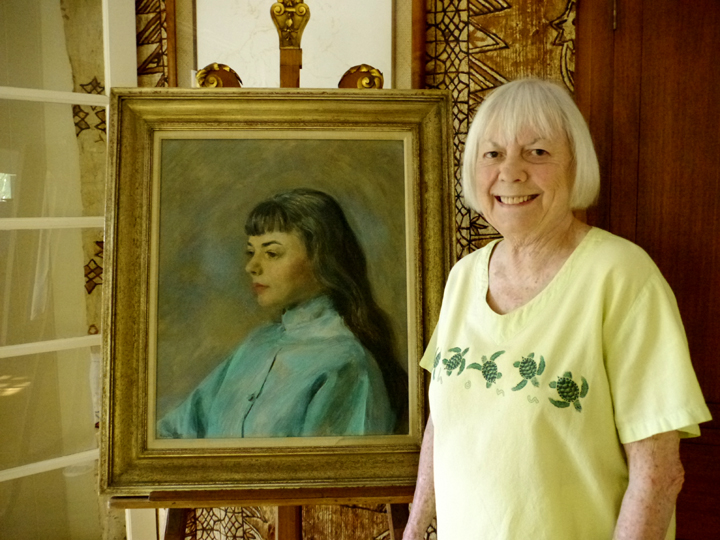
Susan Cummings with Wyeth portrait
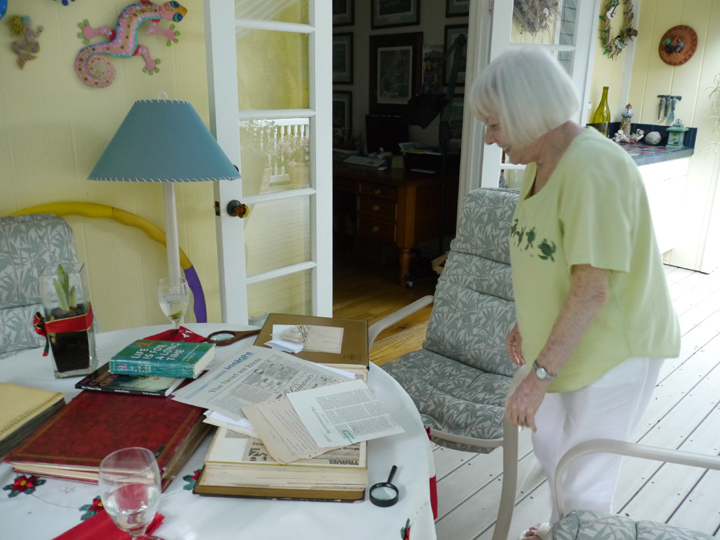
Susan Cummings hunts for clues in her husband’s photo albums
Roy’s photos put more flesh and blood on what had previously been merely names on a page. They also gave me some insight into the lifestyle Rey Scott must have experienced when he first arrived here.

Aloha Tower in the mid 1930s (photo courtesy Susan Cummings)

Like Roy Cummings, Rey Scott holed up in Waikiki when he first got to Hawaii. Could his room have looked like this? (photo courtesy of Susan Cummings)
But the photos didn’t do much to fill in the gaps of the KUKAN story. In fact they brought up more questions than answers. Susan herself was mystified as to what happened between May Day Lo and Roy. Why had he married Margaret Kam instead of May Day? She’d never thought to ask Roy about it when he was alive. I wanted to know if anyone had saved May Day’s papers and if Ling-Ai’s letters or clues to KUKAN were amongst them.
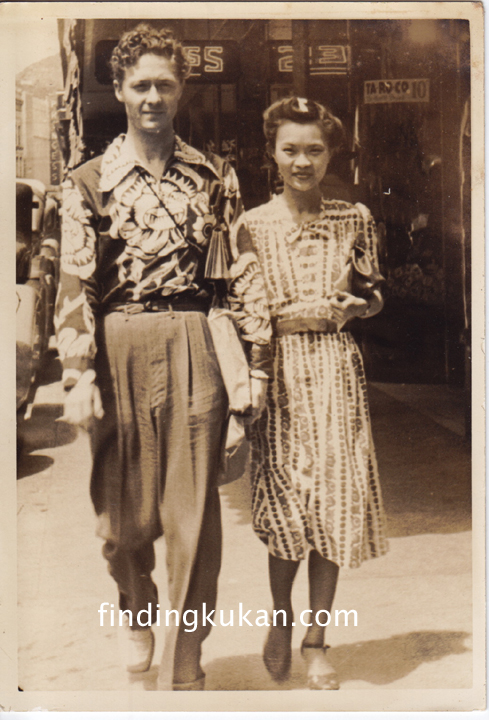
Roy Cummings and May Day Lo in downtown Honolulu (photo courtesy Susan Cummings)
Egged on by mutual curiosity Susan and I exchanged a flurry of emails and research findings in the next few weeks. Susan proved to be a willing and able sleuth, and together we found out some very interesting things which I’ll share in future posts. For now I want to pay tribute to the “father of the Hawaii Newspaper Guild” and thank the ghost of Roy Cummings for putting Susan and I together. Of course the “power of the press” had a lot to do with it too.
Support our 10K in 10 Weeks campaign by clicking the red button. 
(As of 9/24/13 we have raised $7,165 and have $2,835 more to raise by 10/15/13)
The Power of the Press: Part 1– May Day Lo
A blog in support of FINDING KUKAN’s 10K in 10weeks “Keep This Film Alive Campaign”.
In the Lily Wu detective novels by Juanita Sheridan one of the colorful sidekicks is a female reporter named Steve (Stephanie Dugan) who funnels information to her two amateur detective friends Lily and Janice. Since many of her fictional characters are based on real life people, I wondered if Sheridan based Steve on some of the ballsy female reporters who were breaking into newsrooms in the 1930s. So my ears pricked when I heard that Li Ling-Ai had a journalist friend in the 30s and 40s named May Day Lo. Yes, that is her real name, and no she was not even born in May.

May Day Lo at the University of Missouri (photo courtesy Susan Cummings)
In the mid 1930s May Day Lo made history by being one of the first Asian American women hired to report for a major daily newspaper. The progressive Honolulu Star-Bulletin hired Lo and Ah Jook Ku after they graduated from the University of Missouri Journalism School. May Day Lo also broke ground at Journalism School by being the first “exchange student” accepted there (remember, Hawaii was still a territory and not officially part of the United States).
Notably, in 2010 when the Asian American Journalists Association put together a list of pioneering Asian journalists, a majority of them were from Hawaii. AAJA historian Chris Chow commented, “Hawaii was more open to multiculturalism. There was recognition that this is an important market and you’d better well serve them (Asian-Americans) if you want to make any money.”
Back in the 30’s, the Star Bulletin seemed to cover stories about local Asians more comprehensively than the rival Honolulu Advertiser. And May Day Lo’s byline was on several early articles written about Li Ling-Ai, including the one that probably prompted Advertiser reporter Rey Scott to call Li Ling-Ai into his office for an interview on that fateful night in 1937 when plans for making KUKAN were first hatched.

Reporter May Day Lo gives front page coverage to fellow Chinese American pioneer — Li Ling-Ai (aka Gladys Li)
I love knowing that a petite Chinese woman who was raised by a reverend in Hilo was the first exchange student at the prestigious University of Missouri School of Journalism and that the power of her pen brought attention to another pioneering Chinese young woman in a way that changed her life forever. I wanted to find out more about May Day Lo, especially when I found an intriguing letter from her to Li Ling-Ai:
July 31, 1941,
Dear Li Ling Ai,
Now that I am home again, it all seems like a dream that I met you and all the others in New York and had such a wonderful time…. Please give my Aloha to Mrs. James Young, Rey Scott and Mr. Ripley when you see them.
May Day Lo had been in New York right around the time when KUKAN premiered at the World Theater just off Broadway! She had met both Rey Scott and Robert Ripley – two key players in Li Ling-Ai’s life at the time. Could May Day hold clues to some of the unsolved mysteries surrounding KUKAN?
Unfortunately May Day had died in a tragic car accident in 1986. May Lee Chung, editor of the ACUW publication that documents so many pioneering Chinese women’s lives (see other posts about this “Orange Bible”), could remember clearly the circumstances of May Day’s death. But she did not know what had become of May Day’s only child David, someone who might be able to tell me more. The trail remained cold until the Power of the Press struck again in 2011. Stay tuned…
Support our 10K in 10 Weeks campaign by clicking the red button. 
(As of 9/6/13 we have raised $5,025 and have $4,975 more to raise by 10/15/13)
August 10, 2012 — Li Ling-Ai 75 Years Ago
When I was invited recently to participate in a conference to commemorate the 75th anniversary of the Nanking Massacre this coming December, I realized that the film KUKAN also celebrates a whole string of 75th year anniversaries. Today happens to be the day that Li Ling-Ai (aka Gladys Li) appeared on the front page of the Honolulu Star Bulletin newspaper, lauded for her desire to fly a plane to support China’s resistance to Japanese invasion.
A month before this Amelia Earhart’s plane disappeared. It’s a reminder that in 1937 airplane flight was still relatively new and few women were undertaking the risky hobby.
Flying a plane is just one of the pioneering feats of Li Ling-Ai and what brought her to the attention of the Advertiser reporter Rey Scott who would eventualy become her filmmaking partner on Kukan.
Also noteworthy is that the author of the Star Bulletin article, May Day Lo, was one of the first Asian American female reporters on a major city newspaper.
Have any other 75th anniversaries to share? Feel free to comment.





